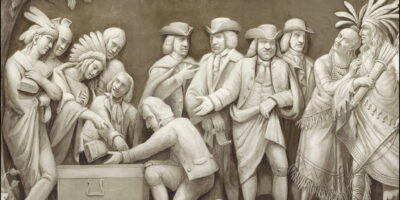My Most Notable Articles of 2019

How Capitalist Abolitionists Fought Slavery
This was my favorite piece to write over the last year because it explored a little-known historical episode in which the New York financier Lewis Tappan used market innovation to advance the abolition of slavery. I wrote it in part to respond to the New York Times’s 1619 Project, which featured an ideologically motivated smear job on market capitalism by Princeton sociologist Matthew Desmond. Whereas Desmond’s piece relied on shoddy historical scholarship to paint capitalism as a pro-slavery institution, Tappan’s experience tells an opposite tale. Facing both a slaveholder-initiated boycott of his business and threats on his company and life from the same quarters over his outspoken anti-slavery views, Tappan founded a privately operated network of credit monitoring agents to independently vouch for financial contracts and ward off fraudsters. The innovation revolutionized the American financial industry, and allowed Tappan to revitalize his business beyond the reach of the slaveowners. He went on to become an important philanthropic supporter of abolitionism, funding publications such as William Lloyd Garrison’s The Liberator and freedom cases in the court system that allowed escaped slaves to fight back against fugitive slave renditions.
In this article I offered my own diagnosis of Modern Monetary Theory (MMT), a politically fashionable economic theory on the far left that seeks to finance government extravagance through the mass-printing of money. While other critics of MMT correctly point to the hyperinflationary risks of this bizarre doctrine, I examine the peculiar academic insularity that its supporters deploy to insulate their claims from scrutiny by other economists. I argue that MMT should be more accurately labelled Postmodern Monetary Theory after the notoriously opaque, equivocating, and epistemically fluid school of philosophy that has taken root in many of the academic humanities.
Introduction to the ‘Best of Karl Marx’
I actually wrote this article as an introductory chapter to a collection of writings from the socialist philosopher Karl Marx that AIER published in conjunction with our Marx vs. Mises rap video release (there’s a corresponding ‘Best of Ludwig von Mises’ as well). Though longer than the typical AIER article, this essay uses the occasion of Marx’s own writings to explore the devastating internal inconsistencies and cluttered reasoning behind his doctrines. The discussion shows that a central premise of Marxist doctrine – the labor theory of value – was rendered obsolete in the economics profession within only a few years of Marx’s most notable work, Das Kapital. Unable to survive the challenges of the Marginal Revolution and an alternative theory of value rooted in individual subjective preference, Marxist doctrine retreated into an ideological echo chamber on the periphery of the profession until a chance event – Soviet revolution – breathed new life into it in 1917. By implication, modern Marxist theory owes its intellectual prominence not to the rigor and quality of Marx’s work itself but to the political boon provided by the Soviets, including the deadly baggage that entails.
Even Swedish Socialism Was Violent
In this piece I examine the little-known history of the modern Swedish welfare state, which is often invoked as a model of functional and peacefully implemented “Democratic Socialism.” This line is frequently deployed by modern socialists to dissociate their cause from the violent and deadly episodes of 20th century communism, and from failed socialist states like Venezuela today. As I show by looking at the history of Sweden’s welfare state though, it too developed under violent auspices in conscious conjunction with a state-sponsored eugenics program designed by the husband and wife time of Gunnar and Alva Myrdal. Although this program did not rack up the body counts of other socialist experiments, it resulted in the sterilization of tens of thousands of “unfit” persons as well as an unprecedented intrusion of the Swedish state into family life. Having taken place within living memory (the program only ended in 1976), Sweden’s “democratic” spin on socialist ideology must still reckon with an inherent violence in its own design and implementation.
School Segregation and Busing: Lessons in Government Failure
This historical piece was precipitated by a peculiar controversy in the ongoing Democratic primary debates, after several candidates began to embrace the discarded 1970s policy of forced busing in public education. I examined the example of Arlington County, Virginia, where busing came about as a direct result of a segregationist political scheme hatched over a decade earlier to intentionally restrict African-American enrollments to a single overcrowded elementary school. The origins of busing, it turns out, are a classic example of government failure in the provision of education, where a racist interest group manipulated the allocation of public resources for self-serving ends.
Why Students are Fleeing the Humanities
Since around 2010 several of the academic humanities have experienced an implosion in enrollment rates and an absolute decline in the number of college students that choose to major in them. Conventional narratives in the media and the academy depict the collapse of the humanities major as a result of alleged but seldom documented budget cuts to higher education. Turning to empirical evidence, I argue for an alternative explanation. The academy underwent a sharp leftward ideological turn in the 2000s that continues to this day. Using survey data, I found a strong correlation between the academic disciplines that are losing students and the leftward ideological skew of their faculty. It turns out that students are voting with their feet and avoiding majors in subjects where the left wing political bias of the faculty is most pronounced.
Climate Activism: An Ideology in Search of a Justification
This short piece originated in a study of the political rhetoric deployed around the climate activism movement, and particularly its propensity toward apocalyptic claims. By comparing the arguments of the first Earth Day event in 1970 to the global warming campaigners of today, a clear pattern of nearly identical imminent doomsaying emerges – albeit for completely opposite and contradictory reasons. Whereas the activists of the 1970s justified their policies around the predicted imminent depletion of fossil fuels after reaching “peak oil” production, today’s activists now contend that the very same fuels are excessively abundant and must be sequestered in the ground for reasons of climate change. In the end, environmentalists seek a fixed set of heavy-handed regulatory policies even though their rationales for reaching them have completely changed.
The Big Fib About the Rich and Taxes
In late September 2019, Berkeley economists Gabriel Zucman and Emmanuel Saez presented the New York Times with proprietary access to an extraordinary economic claim: the United States’ overall effective tax rate on the ultra-wealthy had dropped in the previous year to a level below the rate paid by the poorest Americans. Sympathetic journalists and politicians immediately seized on the statistic to rationalize their support for extreme and confiscatory levels of wealth taxation. Although Saez and Zucman’s statistics made for a popular political talking point, the numbers looked fishy. The rates they reported for the wealthy appeared well below those reported by government statistical agencies. Furthermore, while Saez and Zucman shared their numbers with friendly journalists, they adopted a significantly more opaque stance toward other economists.
In this article I revealed the reasons why, showing the results of an impromptu peer review that myself and a few other economists conducted in real time. It turned out that Saez and Zucman were using several extremely unconventional statistical assumptions to arrive at their numbers, including in ways that violated the findings of their own previously published work. These assumptions all curiously reduced the rates paid by the wealthy by altering their tax incidence from conventional economic models, while increasing the rates paid by the poor through the exclusion of tax benefits such as the Earned Income Tax Credit. In short, Saez and Zucman appear to have intentionally placed their fingers on the scale to bend the results in favor of the wealth tax proposal being sought by Elizabeth Warren’s presidential campaign.
How Twitter is Corrupting the History Profession
In this essay I recounted a strange incident that happened when I published a lengthy criticism of the economic analysis found in the New York Times’ 1619 Project. After I called attention to some suspect statistical claims being used to estimate the economic impact of slavery, I suddenly found myself facing an onslaught of childish name-calling from the corners of Twitter for having questioned an accepted truism of the far left. The name-callers were not random twitter trolls however – they were tenured professors and elite colleges and universities. This led me to the question: why do so many academics behave so badly on twitter?
I wrote this essay in response to a deeply misleading and error-strewn article in the Washington Post that presented an astonishing historical claim: that Abraham Lincoln maintained a philosophical kinship or even long-distance interaction with the communist philosopher Karl Marx. The author of the Post’s article hoped to use this claim to bestow greater legitimacy on “democratic socialism” within the American political ethos. In doing so however, she badly misconstrued historical evidence. Upon closer scrutiny it becomes apparent that Lincoln had no substantive interactions with Marx, and in all likelihood never even knew who Marx was.










